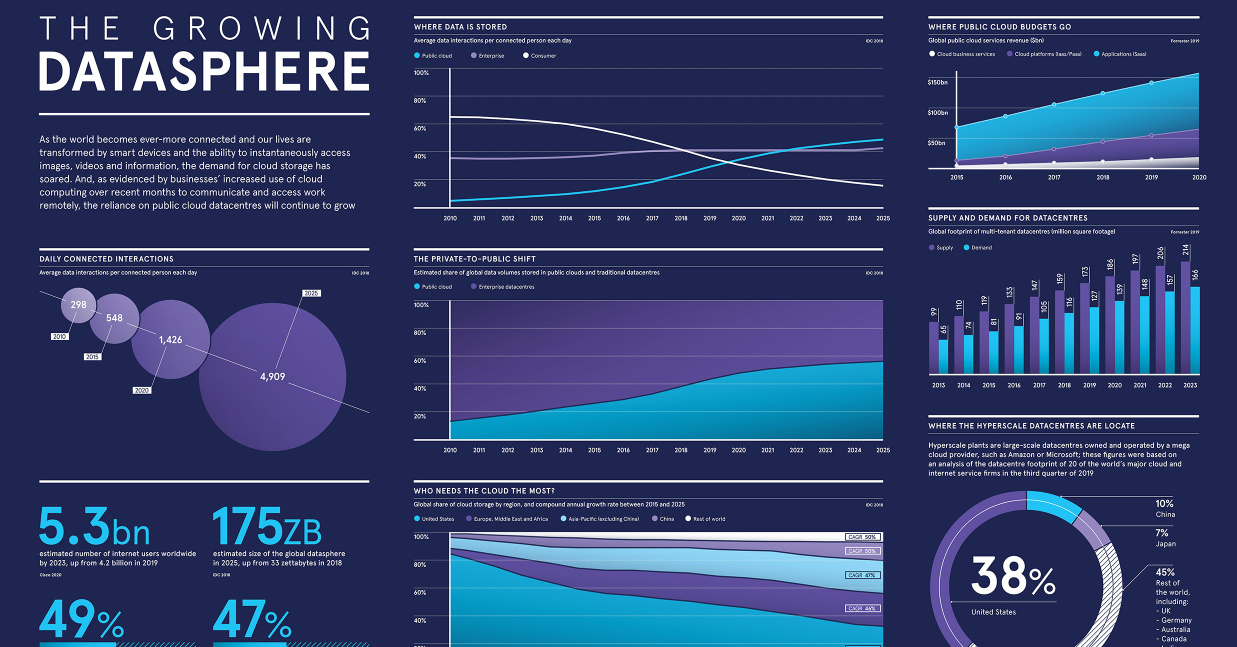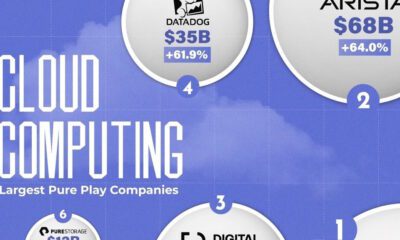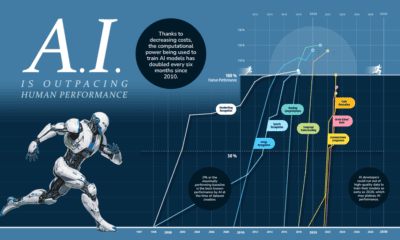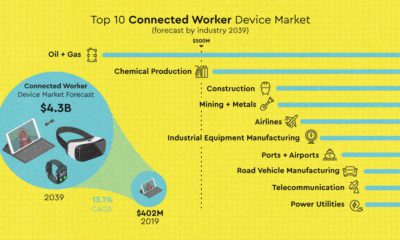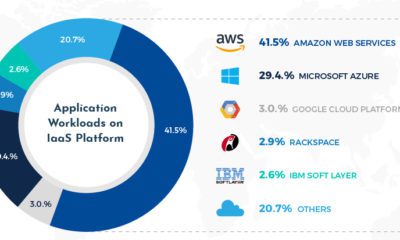Technology
Charting the Massive Scale of the Digital Cloud
View the full-size version of this infographic.
Charting the Massive Scale of the Digital Cloud
View the high resolution of this infographic by clicking here.
Cloud computing continues to be on the rise, and for good reason. It’s transformed our digital experience in numerous ways, from how we store data to the way we share information online with others.
Growth in cloud services is showing no signs of slowing down, particularly in the data storage realm—by 2025, almost half of the world’s stored data will reside in public cloud environments. Yet, despite its increasing popularity among consumers and businesses alike, do people really understand what the cloud fully entails? Or better yet, what the cloud even is?
Today’s infographic from Raconteur provides an overview of the fast-changing cloud computing landscape, showcasing the industry’s growth and its evolution in scale. It also touches on what’s next for the cloud.
What is Cloud Computing?
Put simply, cloud computing is a network of remote servers that provides customers with a number of offerings, including data storage, processing power, and apps. It’s usually delivered on a pay-per-use basis.
Cloud computing can be broken down into three categories:
- Infrastructure-as-a-Service (IaaS): Virtual computing services that businesses can utilize over the internet. IaaS allows businesses to scale up resources when needed, and pay for what they use. Microsoft Azure and Amazon Web Services are both IaaS examples.
- Platform-as-a-Service (PaaS): Like IaaS, PaaS utilizes remote infrastructure, but it includes an extra layer by offering tools that developers use to build apps. Examples of PaaS in action include the Google App Engine or OpenShift.
- Software-as-a-Service (Saas): The delivery of apps through remote servers. This is the type of cloud computing most users are familiar with. Examples include Dropbox and Google Apps.
Cloud computing has its obstacles, such as security and privacy risks. Yet, the cloud continues to entice consumers by offering a new level of accessibility to their online experience.
This accessibility has also drastically changed the working world. The cloud allows users to access company servers from anywhere globally, and to share documents and information with colleagues quickly. Because of this, it’s become a key part of remote work.
IaaS: The Backbone of the Cloud
Cloud services are seeing significant growth, and the big tech companies are its backbone.
In fact, four major players combine to dominate almost 60% of the cloud’s infrastructure. Here’s a look at the cloud market breakdown in 2019, and annual growth compared to 2018:
| Service Provider | 2019 Market Share | Annual Growth |
|---|---|---|
| Amazon Web Services | 32.3% | +36.0% |
| Microsoft Azure | 16.9% | +63.9% |
| Google Cloud | 5.8% | +87.8% |
| Alibaba Cloud | 4.9% | +63.8% |
| Others | 40.1% | +23.3% |
It’s no surprise that U.S. companies dominate the cloud service market since the country currently has the largest share of global cloud storage worldwide. Yet, the concentration of cloud storage is predicted to even out in the next few years—by 2025, the U.S. portion of public cloud storage will drop from 51% to 31%, while China’s will increase from just 6% to 13%.
What’s Next for the Cloud?
The cloud has changed the way we use the internet. It has influenced the way we share information, our ability to work remotely, and how we store our data.
And these services are much needed, as our use of data and the internet continues to scale up. By 2025, an average internet user will have around 4,909 data interactions per day, an increase from 1,426 in the year 2020.
At the same time, the scale of global datasphere is expected to be five times bigger in 2025 than it was in 2018, growing from 33 zettabytes to 175 zettabytes. Each zettabyte, by the way, is equal to 1 trillion gigabytes.
With data taking an ever more important role in our lives, the cloud is becoming an indispensable part of business, technology, and society as a whole.
Technology
All of the Grants Given by the U.S. CHIPS Act
Intel, TSMC, and more have received billions in subsidies from the U.S. CHIPS Act in 2024.

All of the Grants Given by the U.S. CHIPS Act
This was originally posted on our Voronoi app. Download the app for free on iOS or Android and discover incredible data-driven charts from a variety of trusted sources.
This visualization shows which companies are receiving grants from the U.S. CHIPS Act, as of April 25, 2024. The CHIPS Act is a federal statute signed into law by President Joe Biden that authorizes $280 billion in new funding to boost domestic research and manufacturing of semiconductors.
The grant amounts visualized in this graphic are intended to accelerate the production of semiconductor fabrication plants (fabs) across the United States.
Data and Company Highlights
The figures we used to create this graphic were collected from a variety of public news sources. The Semiconductor Industry Association (SIA) also maintains a tracker for CHIPS Act recipients, though at the time of writing it does not have the latest details for Micron.
| Company | Federal Grant Amount | Anticipated Investment From Company |
|---|---|---|
| 🇺🇸 Intel | $8,500,000,000 | $100,000,000,000 |
| 🇹🇼 TSMC | $6,600,000,000 | $65,000,000,000 |
| 🇰🇷 Samsung | $6,400,000,000 | $45,000,000,000 |
| 🇺🇸 Micron | $6,100,000,000 | $50,000,000,000 |
| 🇺🇸 GlobalFoundries | $1,500,000,000 | $12,000,000,000 |
| 🇺🇸 Microchip | $162,000,000 | N/A |
| 🇬🇧 BAE Systems | $35,000,000 | N/A |
BAE Systems was not included in the graphic due to size limitations
Intel’s Massive Plans
Intel is receiving the largest share of the pie, with $8.5 billion in grants (plus an additional $11 billion in government loans). This grant accounts for 22% of the CHIPS Act’s total subsidies for chip production.
From Intel’s side, the company is expected to invest $100 billion to construct new fabs in Arizona and Ohio, while modernizing and/or expanding existing fabs in Oregon and New Mexico. Intel could also claim another $25 billion in credits through the U.S. Treasury Department’s Investment Tax Credit.
TSMC Expands its U.S. Presence
TSMC, the world’s largest semiconductor foundry company, is receiving a hefty $6.6 billion to construct a new chip plant with three fabs in Arizona. The Taiwanese chipmaker is expected to invest $65 billion into the project.
The plant’s first fab will be up and running in the first half of 2025, leveraging 4 nm (nanometer) technology. According to TrendForce, the other fabs will produce chips on more advanced 3 nm and 2 nm processes.
The Latest Grant Goes to Micron
Micron, the only U.S.-based manufacturer of memory chips, is set to receive $6.1 billion in grants to support its plans of investing $50 billion through 2030. This investment will be used to construct new fabs in Idaho and New York.
-

 Science1 week ago
Science1 week agoVisualizing the Average Lifespans of Mammals
-

 Demographics2 weeks ago
Demographics2 weeks agoThe Smallest Gender Wage Gaps in OECD Countries
-

 United States2 weeks ago
United States2 weeks agoWhere U.S. Inflation Hit the Hardest in March 2024
-

 Green2 weeks ago
Green2 weeks agoTop Countries By Forest Growth Since 2001
-

 United States2 weeks ago
United States2 weeks agoRanked: The Largest U.S. Corporations by Number of Employees
-

 Maps2 weeks ago
Maps2 weeks agoThe Largest Earthquakes in the New York Area (1970-2024)
-

 Green2 weeks ago
Green2 weeks agoRanked: The Countries With the Most Air Pollution in 2023
-

 Green2 weeks ago
Green2 weeks agoRanking the Top 15 Countries by Carbon Tax Revenue


